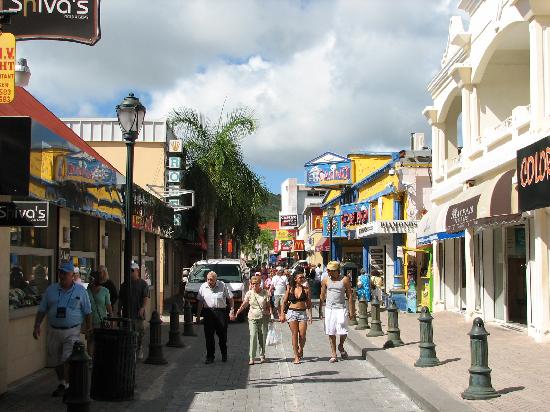(𝘌𝘥𝘪𝘵𝘰𝘳𝘪𝘢𝘭 𝘕𝘰𝘵𝘦: 𝘛𝘩𝘦 𝘌𝘮𝘱𝘭𝘰𝘺𝘦𝘳 𝘊𝘰𝘶𝘯𝘤𝘪𝘭 𝘰𝘧 𝘚𝘵. 𝘔𝘢𝘢𝘳𝘵𝘦𝘯 𝘱𝘳𝘦𝘴𝘦𝘯𝘵𝘦𝘥 𝘪𝘵𝘴 𝘱𝘰𝘴𝘪𝘵𝘪𝘰𝘯 𝘰𝘯 𝘖𝘤𝘵𝘰𝘣𝘦𝘳 31, 2025. 𝘋𝘶𝘦 𝘵𝘰 𝘶𝘯𝘧𝘰𝘳𝘦𝘴𝘦𝘦𝘯 𝘤𝘪𝘳𝘤𝘶𝘮𝘴𝘵𝘢𝘯𝘤𝘦𝘴 𝘛𝘩𝘦 𝘗𝘦𝘰𝘱𝘭𝘦𝘴' 𝘛𝘳𝘪𝘣𝘶𝘯𝘦 𝘸𝘢𝘴 𝘶𝘯𝘢𝘣𝘭𝘦 𝘵𝘰 𝘢𝘵𝘵𝘦𝘯𝘥 𝘵𝘩𝘢𝘵 𝘴𝘦𝘴𝘴𝘪𝘰𝘯. 𝘞𝘦 𝘵𝘩𝘢𝘯𝘬 𝘵𝘩𝘦 𝘤𝘰𝘶𝘯𝘤𝘪𝘭 𝘧𝘰𝘳 𝘱𝘳𝘰𝘷𝘪𝘥𝘪𝘯𝘨 𝘪𝘵𝘴 𝘱𝘳𝘦𝘴𝘦𝘯𝘵𝘢𝘵𝘪𝘰𝘯 𝘢𝘯𝘥 𝘧𝘪𝘯𝘥𝘪𝘯𝘨𝘴 𝘵𝘰 𝘶𝘴).
GREAT BAY--A recent presentation by the Employer Council of St. Maarten has put a sharp spotlight on how the country measures its own economy, arguing that tourism exports, GDP and key fiscal ratios are being overstated because of the way visitor arrivals and spending are counted. Their analysis sits next to the official GDP publications for 2014 to 2021 (Central Bank / Department of Statistics STAT) which already shows how hard the economy was hit by Hurricane Irma and COVID, and how only a partial recovery has taken place.

Together, the STAT figures and the Employer Council’s presentation raise a central question: is St. Maarten operating with an economy close to 3 billion guilders and relatively moderate debt and tax ratios, or with an economy closer to 1.8 billion guilders, where public finances are much tighter than they appear on paper?
What the official GDP data shows
The GDP 2021 publication provides the latest fully compiled series in current and constant prices from 2014 through 2021.
Nominal GDP (current prices)
Gross Domestic Product at current market prices, in millions of guilders, is reported as:
- 2014: 2,437.6
- 2015: 2,538.0
- 2016: 2,554.4
- 2017: 2,422.2
- 2018: 2,254.0
- 2019: 2,520.1
- 2020: 2,213.2
- 2021: 2,422.0
The associated annual nominal growth rates are:
- 2015: +4.1 percent
- 2016: +0.6 percent
- 2017: −5.2 percent
- 2018: −6.9 percent
- 2019: +11.8 percent
- 2020: −12.2 percent
- 2021: +9.4 percent
By 2021, nominal GDP at 2.422 billion guilders was still about 5.2 percent below the 2016 peak of 2.554 billion, although well above the 2018 trough.
Real GDP (constant 2018 prices)
At constant 2018 prices, in millions of guilders, the series is:
- 2014: 2,589.3
- 2015: 2,592.0
- 2016: 2,617.1
- 2017: 2,419.9
- 2018: 2,254.0
- 2019: 2,501.1
- 2020: 2,168.0
- 2021: 2,267.3
The reported real growth rates are:
- 2015: +0.1 percent
- 2016: +1.0 percent
- 2017: −7.5 percent
- 2018: −6.9 percent
- 2019: +11.0 percent
- 2020: −13.3 percent
- 2021: +4.6 percent
Comparing 2016 to 2021, real GDP fell from 2,617.1 million to 2,267.3 million, a decline of about 13.4 percent over five years, even after the rebound in 2019 and 2021.
In simple terms, the official series describes:
• A relatively stable real economy before Irma
• A sharp contraction in 2017 and 2018
• A strong but incomplete recovery in 2019
• A second large contraction in 2020 due to COVID
• A partial recovery in 2021, still well below the 2016 level
Sector data confirms the central role of tourism related activities. Accommodation and food service activities alone account for about 245 million guilders in current prices in 2021, roughly 10 percent of nominal GDP. When tourism driven parts of trade, transport and recreation are included, the tourism share is much larger, even though there is no single tourism line in the GDP table.

What the Employer Council says is wrong with the tourism numbers
The Employer Council of St. Maarten bases its presentation on official sources: the Central Bank of Curaçao and St. Maarten, the TEATT statistics department (STAT), CFT reports, SZV data, airport statistics and other published documents. The council says it is not attacking institutions themselves, but is questioning how data on tourism and GDP is being interpreted and combined.
The council’s core points are:
• Stayover arrivals attributed to the Dutch side are overstated.
• Tourism expenditure in the balance of payments, recorded as “travel exports”, is therefore too high.
Because tourism exports dominate the export side of the economy, this likely inflates measured GDP and makes tax to GDP and debt to GDP ratios look lower than they really are.
The Employer Council stresses that St. Maarten / Saint Martin is a dual jurisdiction island that uses a shared airport, PJIA, as a hub. Methods that work for single jurisdiction islands like Bonaire, Curaçao or Aruba become less reliable here, because many passengers who land at PJIA do not stay on the Dutch side at all.
The presentation highlights examples where PJIA passenger movements are converted to arrival numbers, then compared to published stayover visitor statistics. In one example, 1.95 million passenger movements are said to translate into roughly 1 million arrivals, of which about 550,000 do not stay on St. Maarten. In another, 1.18 million passenger movements equate to around 600,000 arrivals, with about 60,000 not staying on St. Maarten.
The council then compares these indicative figures to published stayover counts. It points out that if Dutch side stayover visitors truly exceeded 500,000 between January and July 2025, very little room would remain for transit passengers and French side visitors, even though PJIA functions as a regional gateway. Using hotel and rental occupancy data, the Employer Council estimates a more realistic figure of around 270,000 stayover visitors on the Dutch side for that period, rather than 528,000, and says the economic implications of that difference are significant.
A 763 million guilder gap in tourism exports
Tourism exports appear in the balance of payments as “travel exports”, compiled by the Central Bank. The Employer Council compares these figures with the Tourism Exit Survey published by STAT, which reports visitor counts and average spending for both stayover and cruise visitors. In principle, the two sources should align after basic adjustments.
Instead, the council reports that for 2023, Central Bank travel exports exceed the exit survey based estimate of tourism spending by 763 million guilders, about 71 percent more than the exit survey total.
In September 2024, the Central Bank began publishing separate charts for cruise and stayover expenditure within the travel exports line. The Employer Council uses these splits, together with the exit survey data, to build a comparison table. It concludes that Central Bank arrival assumptions appear to match PJIA based arrival counts more closely than STAT’s stayover visitor figures do, and that the most plausible explanation is that PJIA arrivals, which include passengers headed to the French side and other islands, are being used directly in stayover expenditure estimates for Dutch St. Maarten.
If that is correct, part of the spending that takes place on the French side or elsewhere is being counted as travel exports for Dutch St. Maarten and, by extension, as part of Dutch side GDP.

How the Employer Council checks the numbers
To test whether official tourism figures are realistic, the council brings in two independent data sets.
Vacation rental and hotel occupancy
In early 2024, the St. Maarten Hospitality & Trade Association received a data set from Lighthouse Intelligence on independent vacation rentals. The data distinguishes between Dutch and French side listings and includes occupancy rates and average daily rates by month.
The Employer Council notes that SHTA already holds Dutch side hotel and resort occupancy information. By combining these occupancy series with exit survey data on party size and length of stay, the council constructs estimates of total stayover visitors on the Dutch side and on the French side.
The council’s summary finding is that independent vacation rentals on the French side are more numerous, more occupied and more expensive than those on the Dutch side. When these occupancy based estimates are compared with official arrival figures for 2023 and 2024, the council concludes that Dutch tourism arrivals still appear to include a sizable number of visitors who in reality stay on the French side.
From this, the Employer Council infers that even the more conservative STAT figures likely overstate Dutch side stayover tourism, which means that some French side spending is being attributed to Dutch side economic output.
Foreign credit card spending
The second check uses Central Bank “Yellow book” statistics on foreign issued credit card transactions in St. Maarten, which track tourism related spending. There is a comparable series for Curaçao, which allows a benchmark comparison.
The council calculates total visitor days as cruise visitors plus stayover visitors multiplied by their average length of stay, based on the exit survey. It then compares travel exports per visitor day for St. Maarten and Curaçao.
According to the presentation, St. Maarten shows lower spending per visitor day than Curaçao, despite very high travel export totals in its balance of payments. The council offers two overlapping explanations: that exit survey stayover numbers for St. Maarten are inflated, which lowers the apparent spend per day, and that part of the assumed spend per day includes French side activity that is not captured in the St. Maarten credit card data.
The Employer Council argues that the foreign credit card volumes reported for St. Maarten do not support the elevated travel export figures currently recorded in the balance of payments.
From travel exports to GDP: two very different pictures
With tourism identified as the main export driver, the Employer Council connects these measurement issues back to GDP. The presentation reminds us that GDP can be computed by expenditure, by value added or by income, and that in all three cases the export component is crucial in a small open economy like St. Maarten.
The council stresses that if travel exports are overstated, then the expenditure based calculation of GDP will be too high, even if sector value added and income based calculations are consistent with a smaller tourism sector.
To give context, the Employer Council points to Aruba, where tourism expenditure typically amounts to about 70 percent of GDP, and notes that Aruba, like St. Maarten, has few large non tourism industries. Applying a similar ratio to exit survey based tourism expenditure for St. Maarten suggests a smaller GDP than the one implied by current Central Bank travel export numbers.

The council does not publish a full recalculated GDP time series. It does, however, outline two scenarios for recent years:
• An “official style” scenario, reflecting current methods, in which GDP is about 3 billion guilders. In this picture, government income to GDP is about 34 percent, and debt to GDP is about 42 percent.
• An “adjusted” scenario, based on reduced stayover tourism and corrected exports, in which GDP is closer to 1.8 billion guilders. Here, government income plus SZV contributions amount to about 41 percent of GDP, and debt to GDP rises to around 71 percent.
The Employer Council argues that the adjusted scenario produces GDP levels that are more consistent with pre Irma nominal GDP and with independent spending indicators, while still implying a weaker real economy once inflation is factored in. In that adjusted picture, St. Maarten’s tax and contribution burden looks similar to that of high tax European countries, while available public services and buffers are smaller. At the same time, a debt ratio above 70 percent suggests limited space for further borrowing. By contrast, the 3 billion GDP scenario yields more comfortable ratios and a less urgent view of fiscal risk.
How the two sets of numbers align, and where they diverge
The CBS GDP table and the Employer Council’s analysis do not conflict about the direction of the economy. Both point to a country that has not fully regained its 2016 level of activity in real terms, even by 2021, after Irma and COVID.
Where they diverge is on the current scale of the economy and how that scale is being inferred from tourism data.
On one side, official GDP reached 2.422 billion guilders in 2021 and has likely grown since, and Central Bank travel exports appear high relative to exit survey based tourism spending. On the other, the Employer Council points to arrival counts that treat PJIA as if it served a single jurisdiction, a 763 million guilder gap between travel exports and exit survey tourism expenditure for 2023, and occupancy and credit card data that, in the council’s view, do not support the higher export estimates.
The Employer Council’s presentation does not claim to be the final word, but it makes a consistent case that how St. Maarten counts its tourists and their spending has a direct and material impact on how large its economy appears and how safe its public finances look. The official GDP table shows an economy still below its pre Irma peak in real terms. The council’s critique suggests that if tourism is measured more narrowly, the economy may also be smaller in nominal terms, which would lift tax and debt ratios and narrow the margin for policy error.
Join Our Community Today
Subscribe to our mailing list to be the first to receive
breaking news, updates, and more.






%20(412%20x%20570%20px)%20(412%20x%20340%20px).jpg)